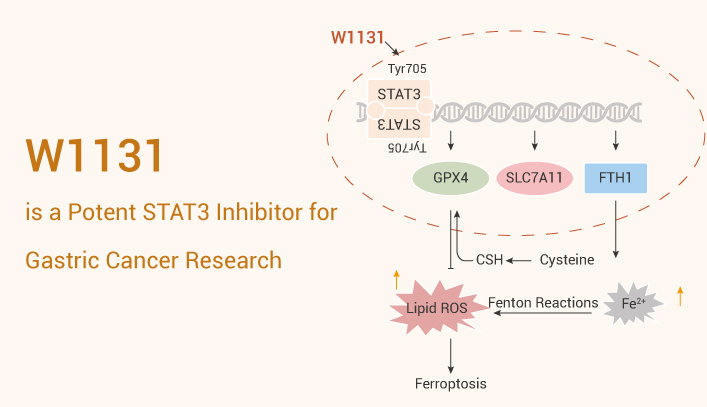STAT3 is a key oncogene whose overactivation leads to cancer. As a transcription factor, it exhibits dual functions of signal transduction and transcriptional activation. Gastric cancer is a malignant tumor usually inhibited by 5-FU chemotherapy. However, this therapy can easily lead to resistance of cells to 5-FU. Therefore, the researchers found that induction of ferroptosis may be able to solve the problem of cell drug resistance. Furthermore, STAT3 may be a potential regulator of ferroptosis. STAT3 inhibition may lead to the activation of ferroptosis, which inhibits tumor cell growth. Specifically, STAT3 mediates ferroptosis by binding to consensus response elements in the promoters of SLC7A11, GPX4, and FTH1 genes. Here, we’ll introduce a selective STAT3 inhibitor, W1131.
W1131 inhibits W1131 and induces ferroptosis to defeat gastric cancer cells.

As for in vitro assay, W1131 (2 μM; 72 h) inhibits cell survival, migration, and invasion in gastric cancer AGS cell, and also inhibits colony formation for 3 days of treatment. It (0.1-3 μM; 24 h) dose-dependently inhibits the phosphorylation of STAT3. And also, it (1 μM; 48 h) triggers ferroptosis and suppresses GPX4, SLC7A11, and FTH1 expression in gastric cancer.
As for in vivo assay, W1131 (3 mg/kg, 10 mg/kg; i.p.; once daily for 2 weeks) inhibits tumor growth dose-dependently in the mouse model. It induces ferroptosis in vivo in mice of the MGC803 cell xenograft model, gastric cancer organoids model, and PDX model. Importantly, it re-sensitizes resistant cancer cells to 5-FU, and inhibits cell growth as well.
Overall, W1131 is a potent STAT3 inhibitor and ferroptosis inducer with in vitro and in vivo efficacy. It also significantly alleviates 5-FU resistance for gastric cancer.
Reference:
[1] Ouyang S, et al. Redox Biol. 2022 Jun;52:102317.